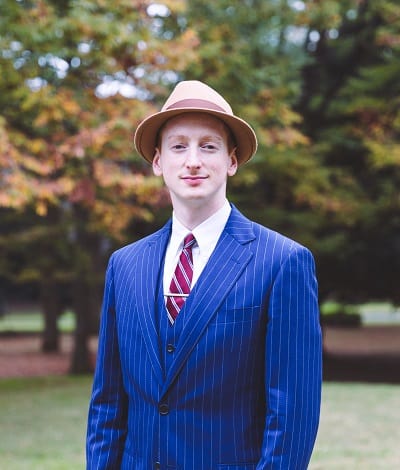1. Prelude
Hello everyone and welcome to my article on Kacho-ga. In this article, I will talk about the Kacho-ga, his history, his main artists and beautiful woodblock prints of this sub-genre of Ukiyo-e.
Reading this article will take less than 15 minutes.
Please, enjoy your reading and don’t hesitate to comment. If I made any mistake, I will do my best to correct it as quickly as possible.
Summary
- Prelude
- Kacho-ga definition
- Etymology of Kacho-ga
- The origins of Kacho-ga
- In China, we go.
- Famous artist of the Kacho-ga style
- Hokusai, the grand kacho-ga master
- Keisai Eisen
- Hiroshige
- Hiroshige II
- Hiroshige III
- Utagawa Kuniyoshi
- Kitagawa Utamaro
- Kitao Masayoshi
- Isoda Koryūsai
- Ohno Bakufu
- Takahashi Shōtei
- Imao Keinen
- Conclusion
2. Kacho-ga definition
Kacho-ga is a Japanese art sub-genre of Ukiyo-e which depicts birds and flowers; Ukiyo-e describing bird, flower, fish or insects and natural scenery can be included in the Kacho-ga genre.
The word Kacho-ga can be found in multiple orthography, such as Kachoga, Kachō-ga or Kachōga.
3. Etymology of Kacho-ga
In Japanese the word “Kacho-ga” is written like this:
As you can see this word is composed of 3 characters (3 kanjis):
- The first kanji is 花 which means “flower” and his reading is “ka”.
- The second kanji is 鳥 which means “bird” and his reading is “cho” or “chō”.
- The third kanji is 画 which means “picture” and his reading is “ga”.
When we translate this Japanese word into English:
4. The origins of Kacho-ga
In China, we go.
Kacho-ga origins comes from the Chinese culture of the 10th century. During this period, there was two famous Chinese artists known for their bird and flower paintings, Huang Quan 哳㥳 (900–965) and Xu Xi 徐熙 (937–975).
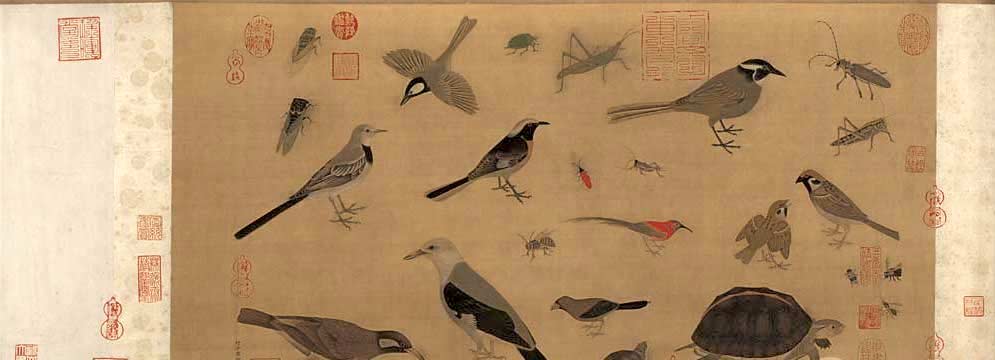 (Birds, Insects and Turtles by Huang Quan, Kacho-ga)
(Birds, Insects and Turtles by Huang Quan, Kacho-ga)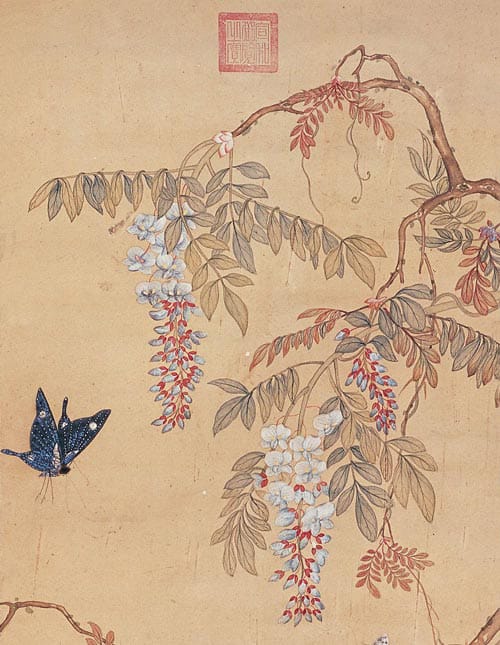 (Butterfly and Chinese Wisteria Flowers by Xu Xi,Kacho-ga)
(Butterfly and Chinese Wisteria Flowers by Xu Xi,Kacho-ga)Famous artist of the Kacho-ga style
Hokusai, the grand kacho-ga master
When you do an article about kacho-ga, you have to talk about Katsushika Hokusai, one of the most famous ukiyo-e artist. He is not just famous in japan, but a worldwide star. I will present some of his works which most people outside of japan does not know, for the simple reason that The Great Wave off Kanagawa or Fine Wind, Clear Morning of Mount fuji eclipsed his other works (only in my opinion).
So, to get it out of the way, I will first talk about the Thirty-six Views of Mount Fuji which is a well known ukiyo-e series representing mount fuji from different point of view and sceneries.
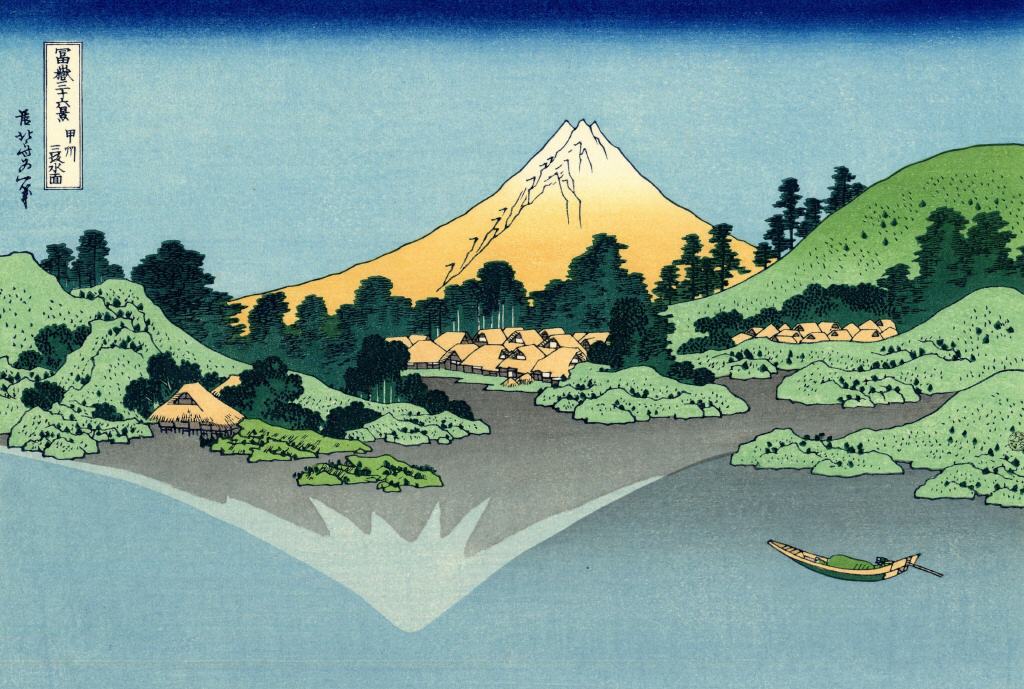 (The Fuji reflects in Lake Kawaguchi by hokusai in the Thirty-six Views of Mount Fuji)
(The Fuji reflects in Lake Kawaguchi by hokusai in the Thirty-six Views of Mount Fuji)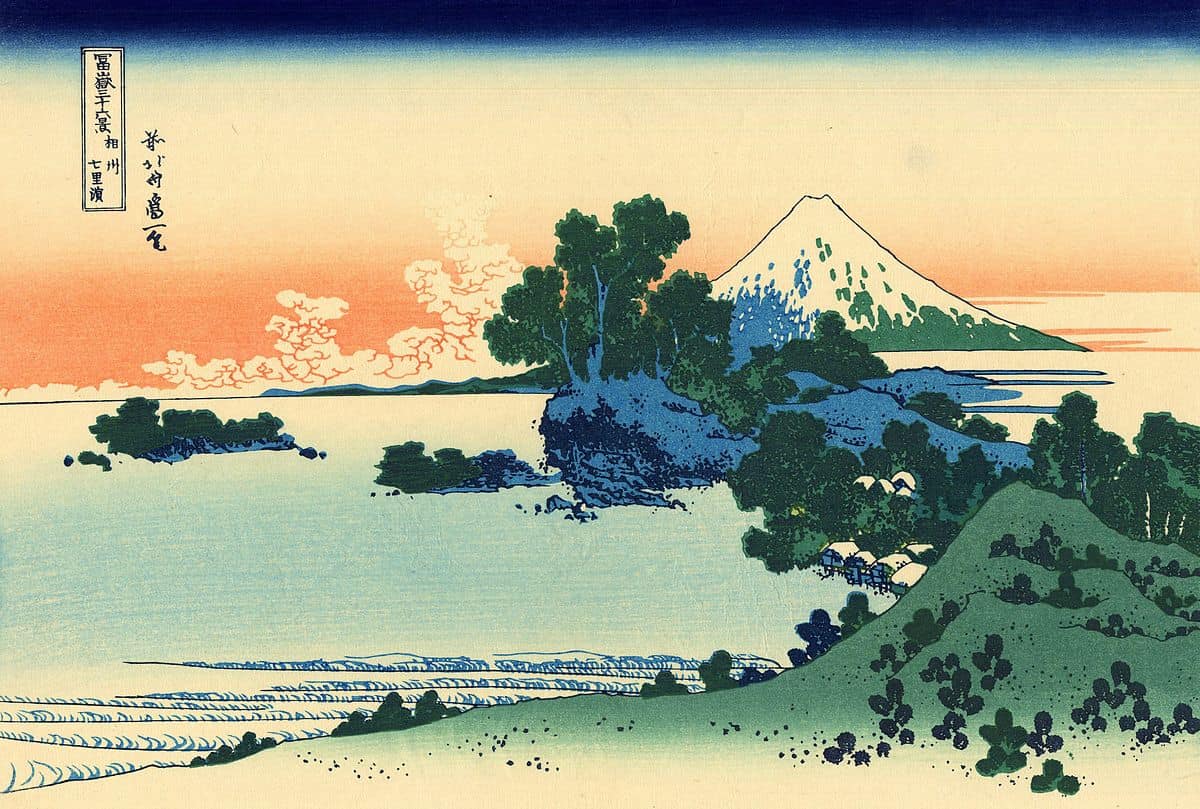 (Shichiri beach in Sagami province by hokusai in the Thirty-six Views of Mount Fuji)
(Shichiri beach in Sagami province by hokusai in the Thirty-six Views of Mount Fuji)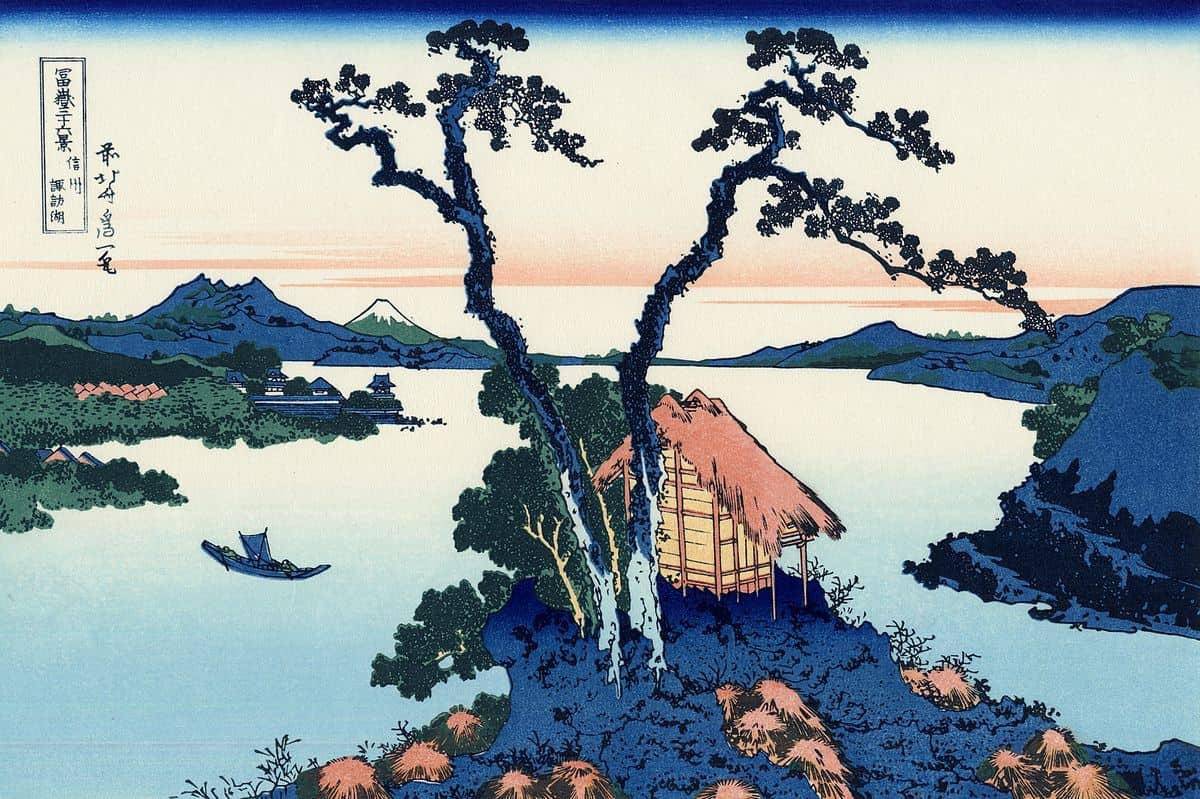 (Lake Suwa in the Shinano province by hokusai in the Thirty-six Views of Mount Fuji)
(Lake Suwa in the Shinano province by hokusai in the Thirty-six Views of Mount Fuji)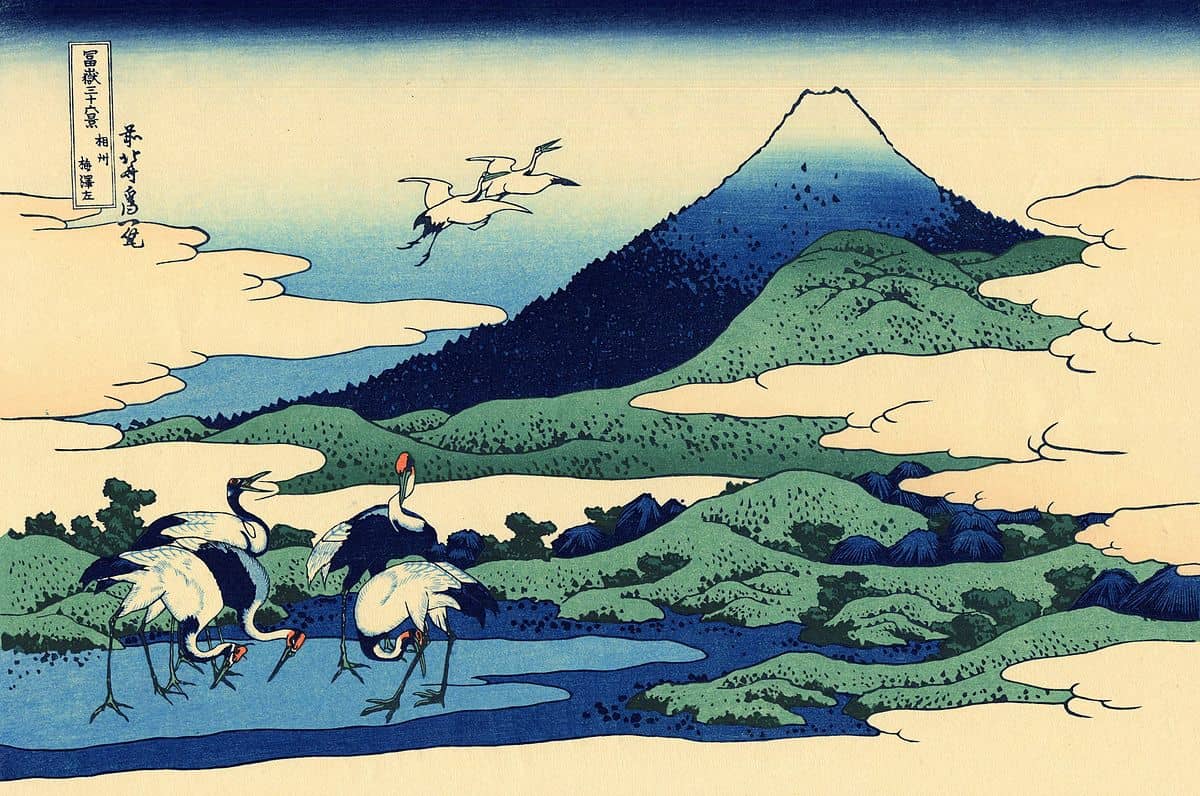 (Umegawa in Sagami province by hokusai in the Thirty-six Views of Mount Fuji)
(Umegawa in Sagami province by hokusai in the Thirty-six Views of Mount Fuji)Now, I will present you some ukiyo-e of hokusai in the kacho-ga genre with the most impressive flowers.
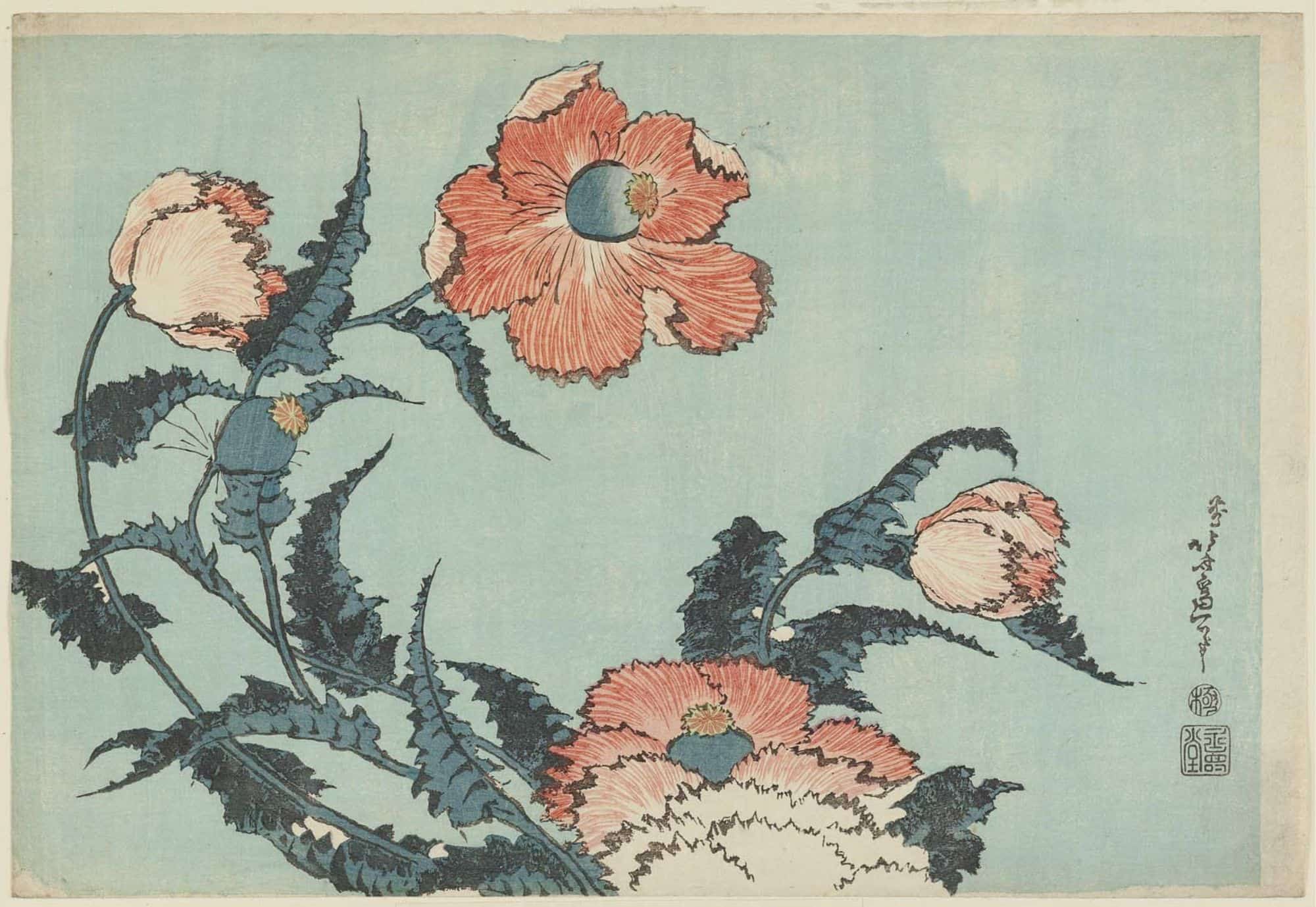 (Poppies by hokusai, kacho-ga)
(Poppies by hokusai, kacho-ga)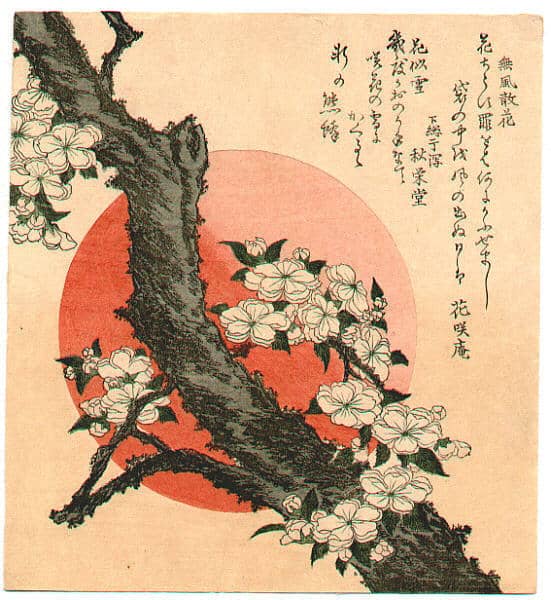 (Flower sunset by hokusai, kacho-ga)
(Flower sunset by hokusai, kacho-ga)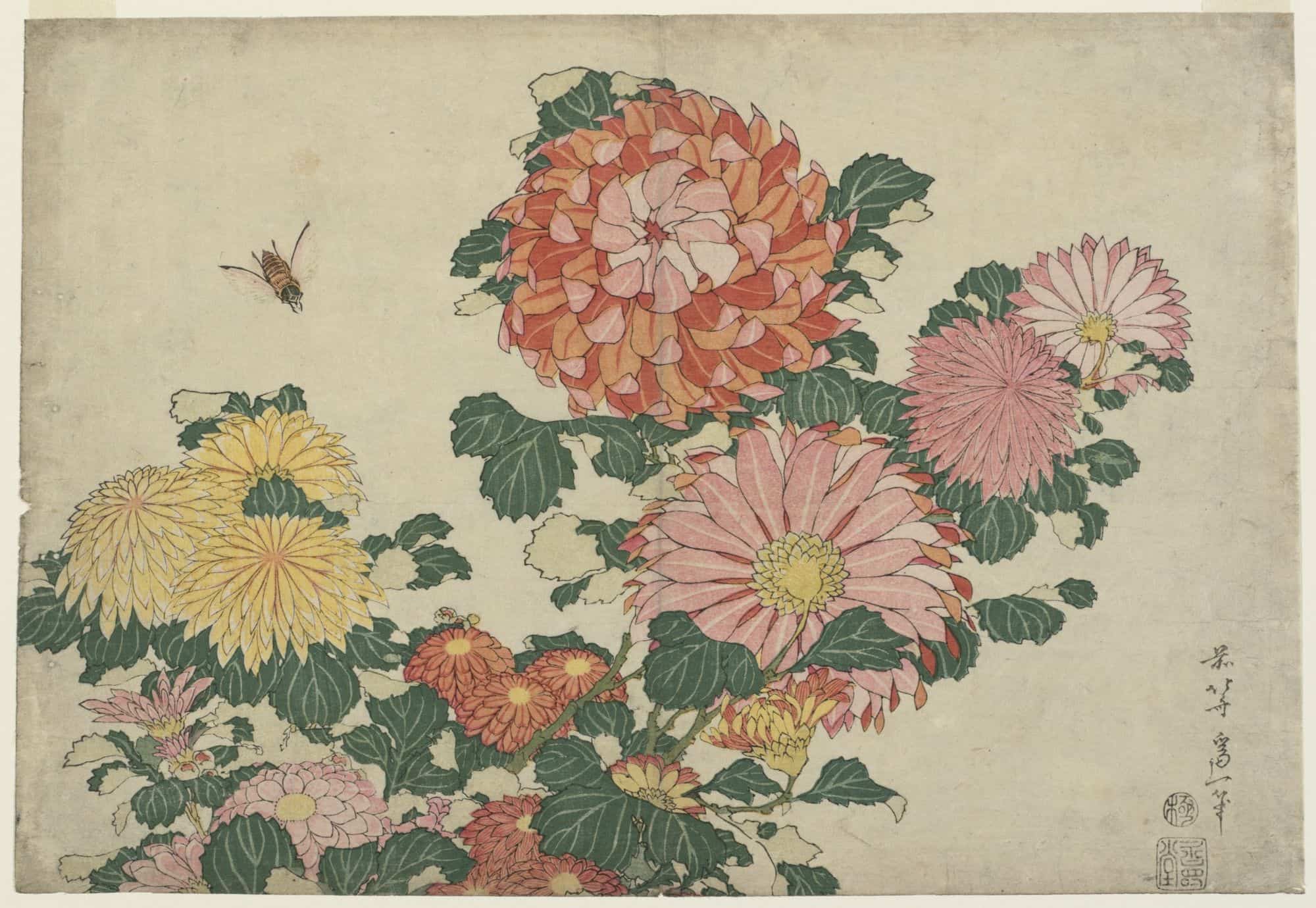 (Chrysanthemums and Horsefly by hokusai)
(Chrysanthemums and Horsefly by hokusai)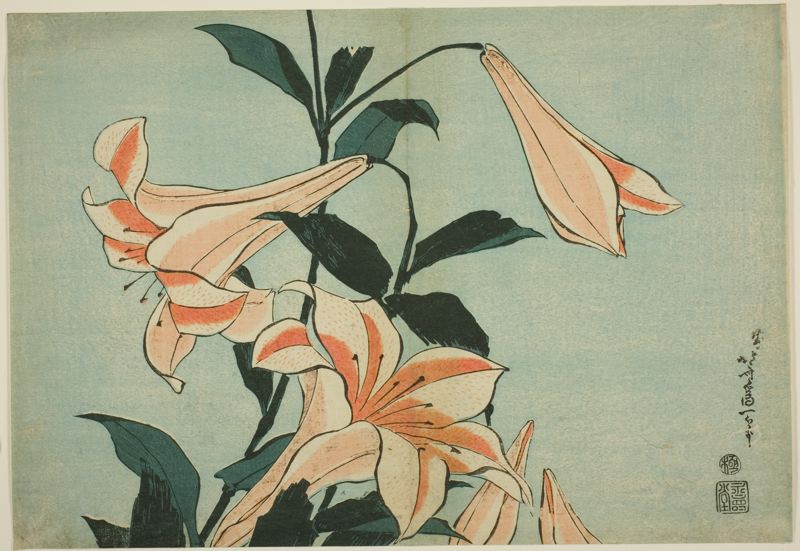 (Lilies by hokusai)
(Lilies by hokusai)Keisai Eisen
Keisai Eisen is a contemporary of Hokusai, he is an ukiyo-e master known for his bijin-ga style with their enormous head. Also, his main style is not kachoga, but he did draw some flowers and birds.
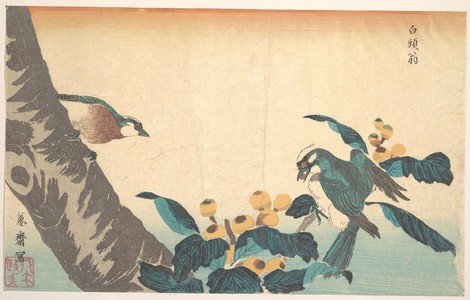 (Birds and Flowers by Keisai Eisen)
(Birds and Flowers by Keisai Eisen)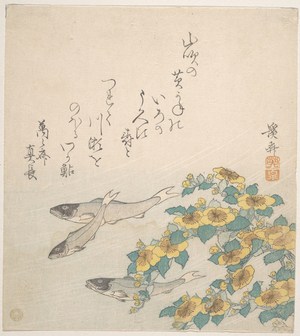 (Fishes Swimming with Yellow Flowers by Keisai Eisen)
(Fishes Swimming with Yellow Flowers by Keisai Eisen)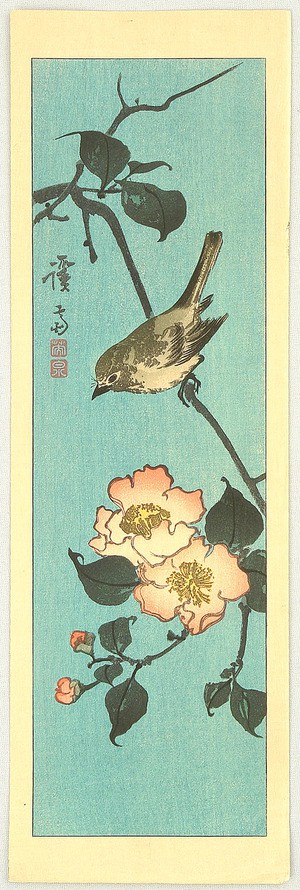 (Bird and Flowering Tree by Keisai Eisen)
(Bird and Flowering Tree by Keisai Eisen)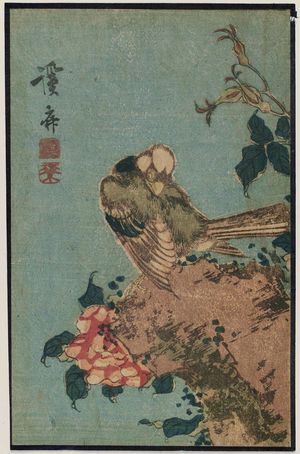 (Bird and flowers by Keisai Eisen)
(Bird and flowers by Keisai Eisen)Hiroshige
Utagawa Hiroshige is a famous ukiyo-e artist which is considered the last ukiyo-e grand master before the decline of the genre. He is famous for his landscape series, such as The Fifty-three Stations of the Tōkaidō.
The difference between these two ukiyo-e masters (Hokusai and Hiroshige) are the more subtle colors and poetic approach of Hiroshige.
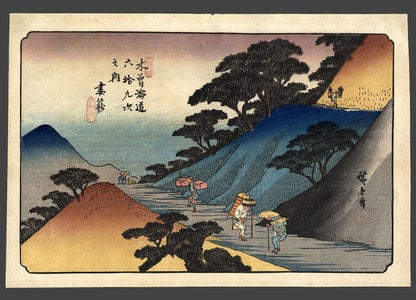 (#43 Tsumago by Utagawa Hiroshige)
(#43 Tsumago by Utagawa Hiroshige)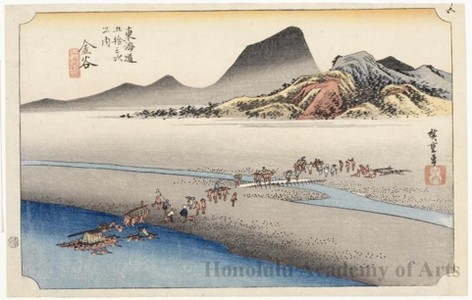 (Distant Bank of Öi River at Kanaya (Station #25) by UtagawaHiroshige)
(Distant Bank of Öi River at Kanaya (Station #25) by UtagawaHiroshige)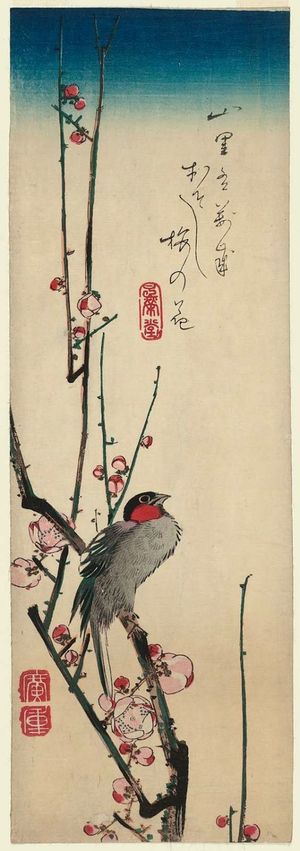 (Red-cheeked Bird and Red Plum Blossoms by Utagawa Hiroshige)
(Red-cheeked Bird and Red Plum Blossoms by Utagawa Hiroshige)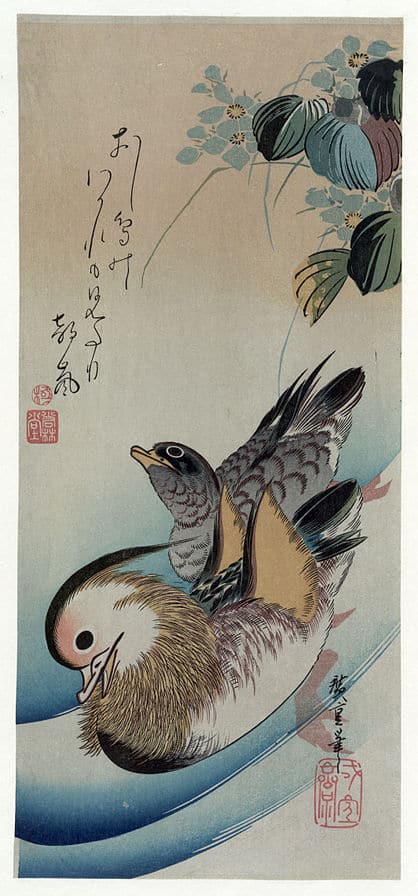 (Two mandarins ducks Hiroshige)
(Two mandarins ducks Hiroshige)Hiroshige II
Hiroshige II inherited the name of his former master after his death and his marriage with his master’s daughter. His work and style are really close to his master, therefore, the scholars have difficulties to differentiate their works.
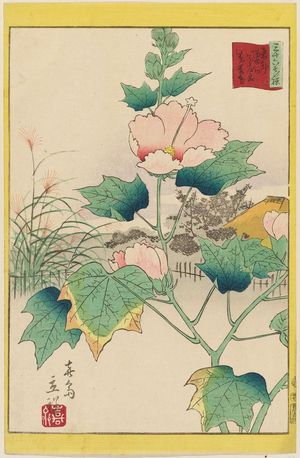 (Hibiscus in the Flower Garden by Utagawa Hiroshige II, kacho-ga)
(Hibiscus in the Flower Garden by Utagawa Hiroshige II, kacho-ga)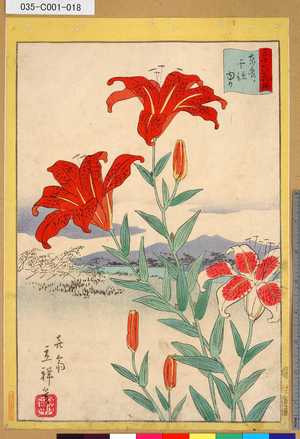 (Tohru Senju Lily by Utagawa hiroshige II)
(Tohru Senju Lily by Utagawa hiroshige II) (Odawara, from the series Scenes of Famous Places along the Tôkaidô Road, Utagawa Hiroshige II)>
(Odawara, from the series Scenes of Famous Places along the Tôkaidô Road, Utagawa Hiroshige II)>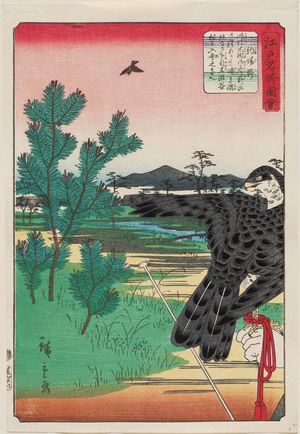 (Komabano, from the series Views of Famous Places in Edo by Utagawa Hiroshige II)
(Komabano, from the series Views of Famous Places in Edo by Utagawa Hiroshige II)Hiroshige III
Utagawa Hiroshige III was also a student of Hiroshige, he took the name of hiroshige III after marring the daughter of his master which divorced with hiroshige II. His style was also very close to his master, yet he didn’t know the same success.
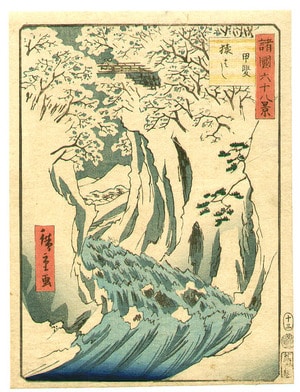 (Monkey Bridge by Utagawa hiroshige III)
(Monkey Bridge by Utagawa hiroshige III)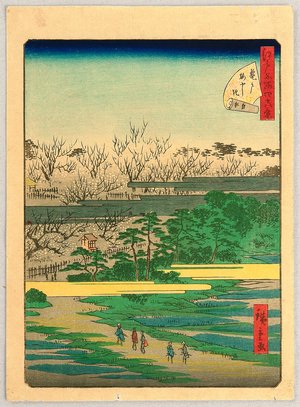 (48 Famous Places of Edo by Utagawa hiroshige III)
(48 Famous Places of Edo by Utagawa hiroshige III)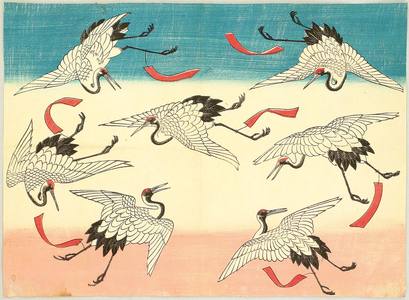 (Flying Cranes by Utagawa hiroshige III)
(Flying Cranes by Utagawa hiroshige III)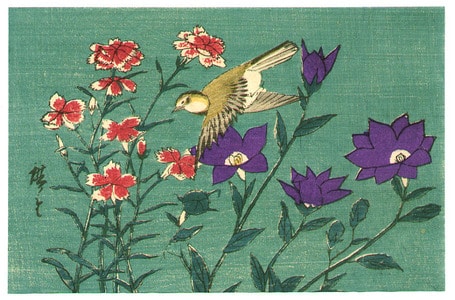 (Bird and Autumn Flowers by Utagawa hiroshige III)
(Bird and Autumn Flowers by Utagawa hiroshige III)Utagawa Kuniyoshi
Here is the part about the very prolific Utagawa Kuniyoshi, he draw a vast variety of ukiyo-e, but here we will focus on his kacho-ga work.
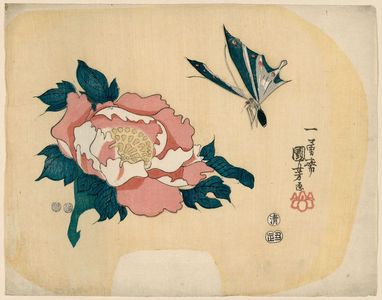 (Butterfly and Camellia by Utagawa Kuniyoshi)
(Butterfly and Camellia by Utagawa Kuniyoshi)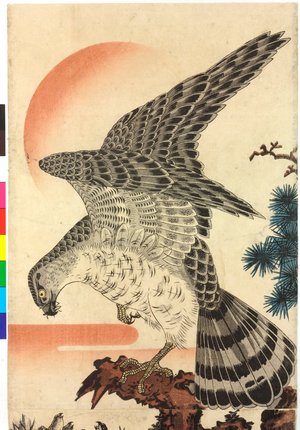 (Hawk and Nestlings in Pine Tree by utagawa kuniyoshi)
(Hawk and Nestlings in Pine Tree by utagawa kuniyoshi)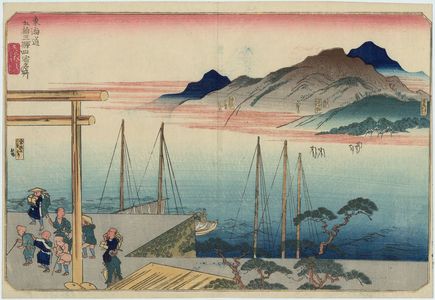 (Fifty-three Stations of the Tôkaidô Road by utagawa kuniyoshi)
(Fifty-three Stations of the Tôkaidô Road by utagawa kuniyoshi)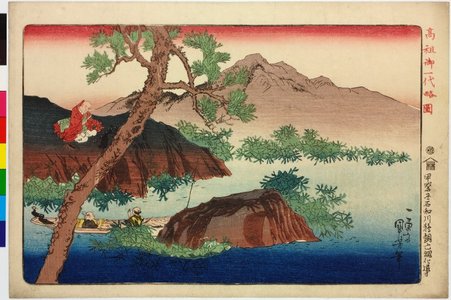 (Converting the Spirit of a Cormorant Fisherman by utagawa kuniyoshi)
(Converting the Spirit of a Cormorant Fisherman by utagawa kuniyoshi)Kitagawa Utamaro
Kitagawa Utamaro was an ukiyo-e artist which could enjoy fame during his lifetime due to his hard work. He was able to produce more than 2000 known prints. He was mainly knowned for his bijinga art, yet, he also created some nature studies, specializing in insects.
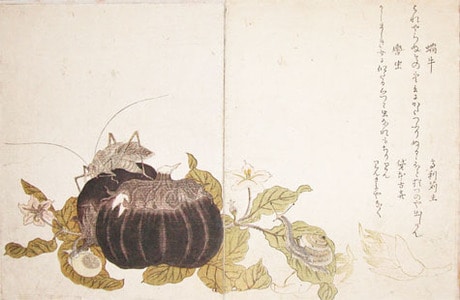 (Land Snail and Giant Katydid, c.1788)
(Land Snail and Giant Katydid, c.1788)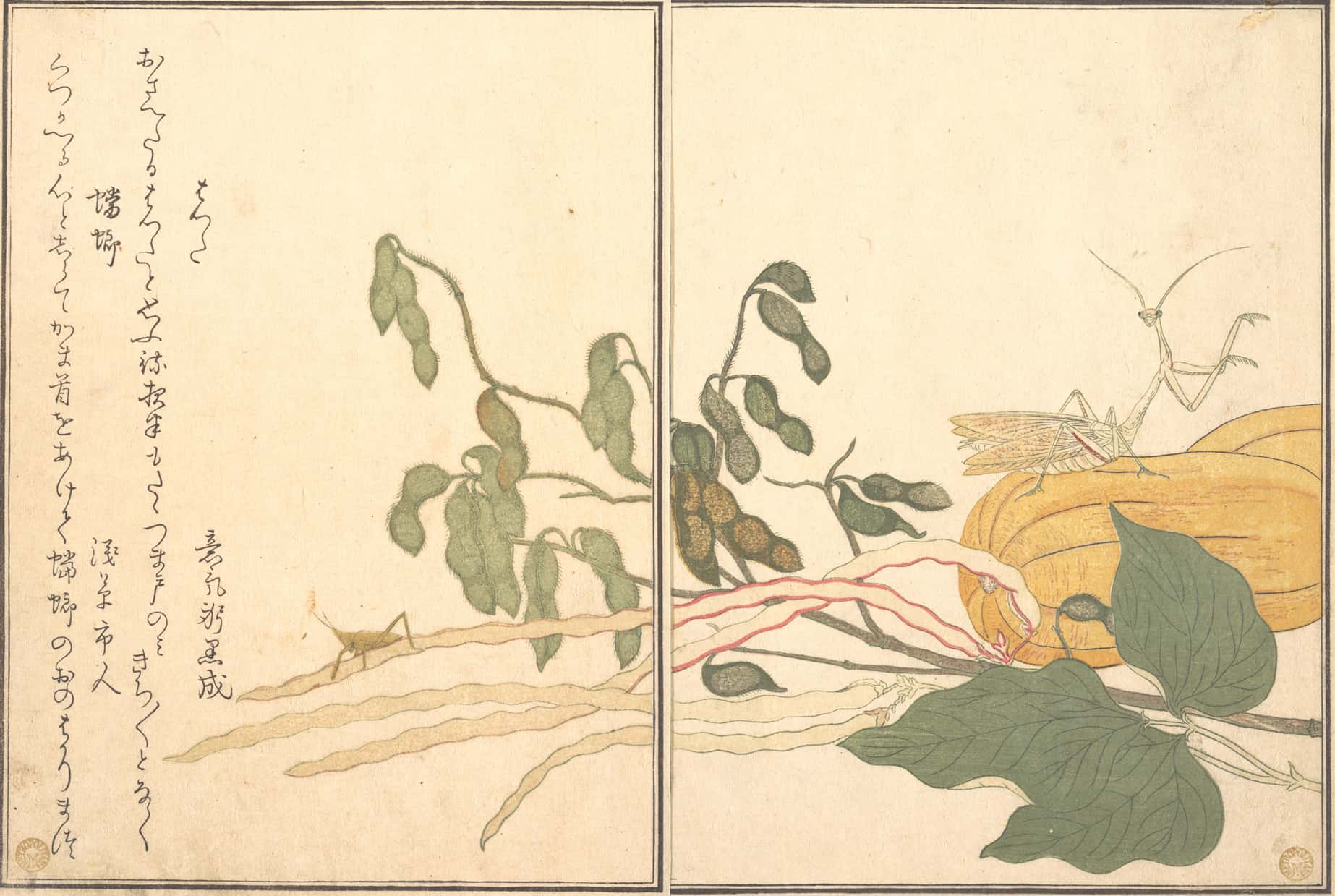 (Praying Mantis and Cone-headed Grasshopper, c.1788)
(Praying Mantis and Cone-headed Grasshopper, c.1788)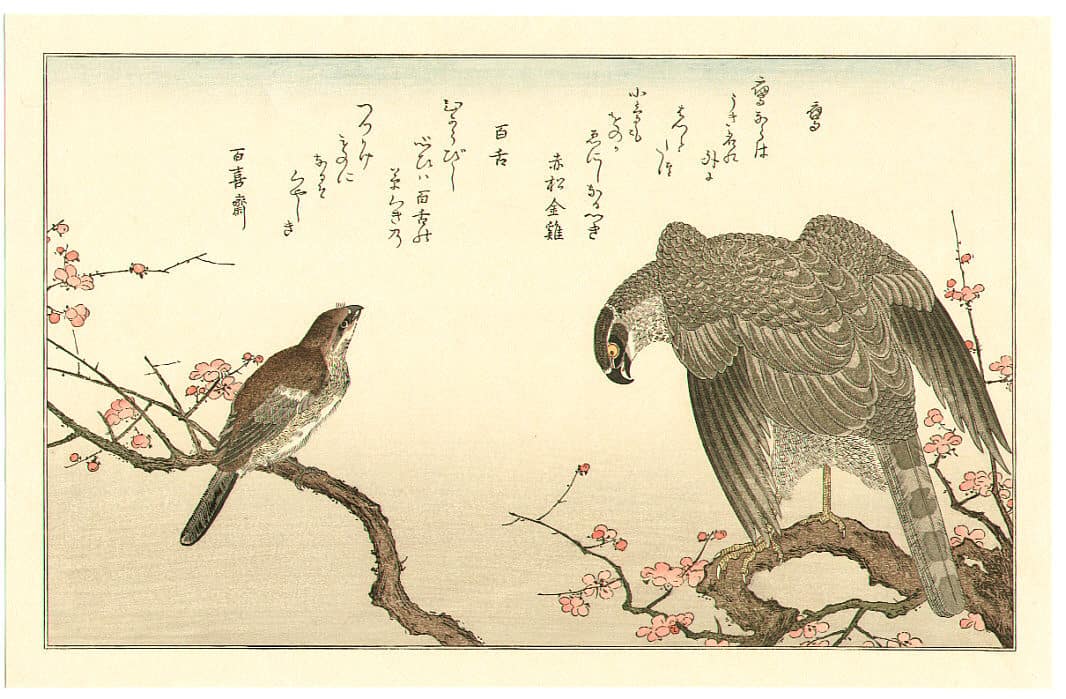 (Hawk and Shrike, c. 1790)
(Hawk and Shrike, c. 1790)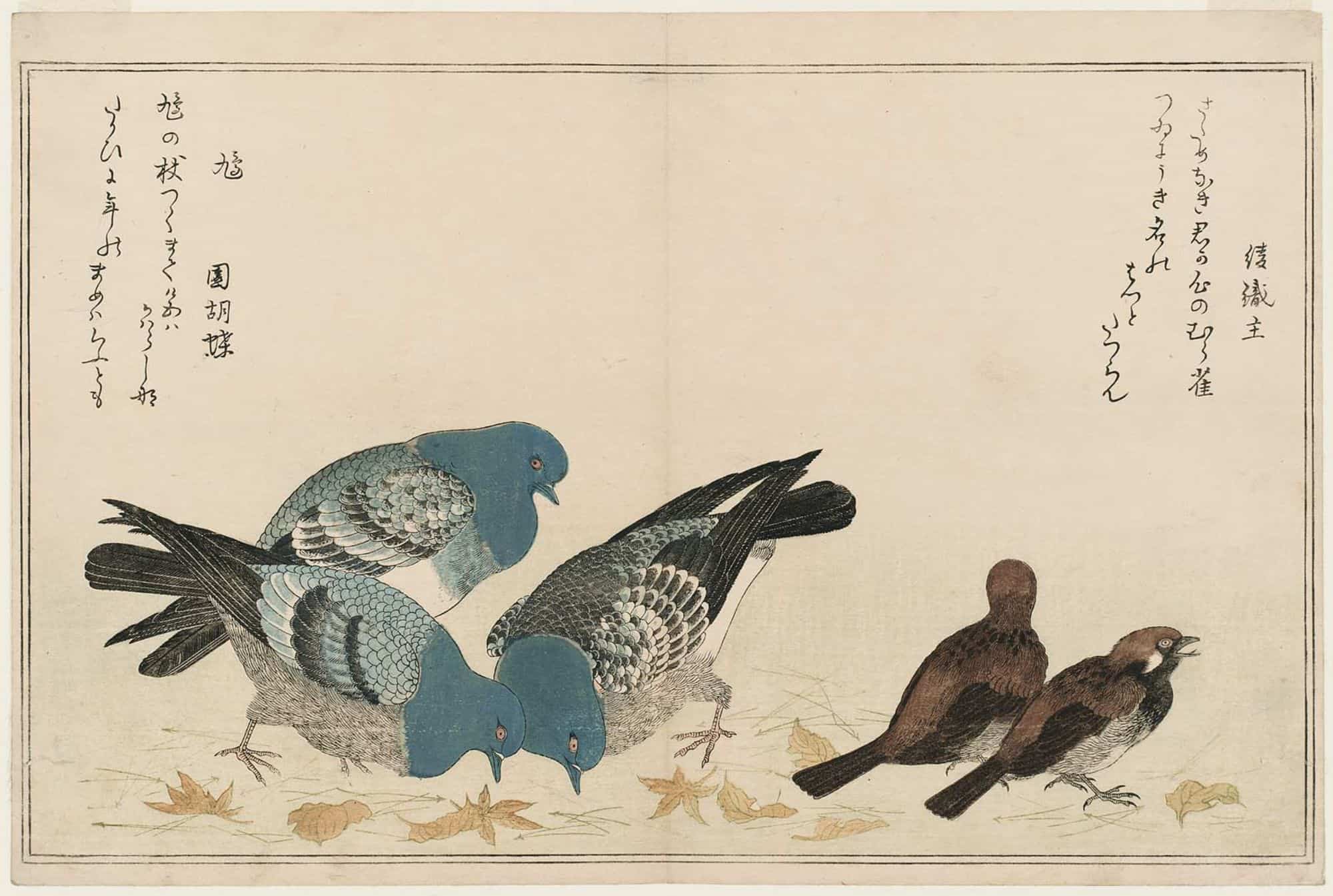 (Sparrows (Murasuzume) and Pigeons (Hato), c.1790)
(Sparrows (Murasuzume) and Pigeons (Hato), c.1790)Kitao Masayoshi
Kitao Masayoshi is an ukiyo-e artist contemporary of Hokusai, it is also said that his contemporary noticed that Hokusai got inspired from his style to draw his “Manga”. His master is Kitao Shigemasa. He is also known as Kuwagata Keisai [鍬 形 蕙 斎] which he takes this name around 1790.
According to his own presentation, the purpose of his drawings “is not to offer forms but the spirit of what they represent. As they do not seek to embellish the forms but rather to simplify them, I weighed in “The method of the abridged drawing””.
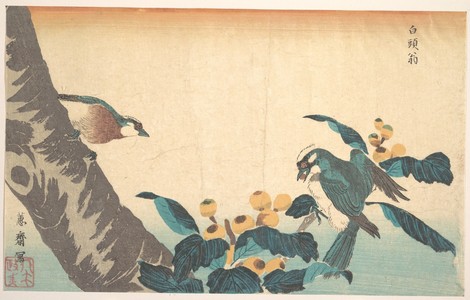 (Birds and Flowers, c. Edo)
(Birds and Flowers, c. Edo) (Camellias with a Bird, c.1789)
(Camellias with a Bird, c.1789) (Two Exotic Birds, c. 1800)
(Two Exotic Birds, c. 1800) (two pheasants by a stream, c. Edo)
(two pheasants by a stream, c. Edo)Isoda Koryūsai
Isoda Koryūsai was a samurai in the service of the Tsuchiya clan, after the death of the head master, he became a rōnin and settled in Tokyo. When he started his career as an ukiyo-e artist, he created samurai-themed design under the name of Haruhiro. Koryūsai was a very productive artist, he is known for more than 2500 designs according to the historian Allen Hockley.
He is the author of the longest ukiyo-e pirnt series of bijin-ga, named as The series Models for Fashion: New Designs as Fresh Young Leaves (Hinagata wakana no hatsumoyō) composed of 140 prints. Isoda Koryūsai, also drawn kacho-e, shunga and hashira-e.
 (Cranes, Waves and Sun, c. Edo)
(Cranes, Waves and Sun, c. Edo) (Egret and Mizu-aoi, c. Edo)
(Egret and Mizu-aoi, c. Edo) (Falcon on Perch, c. Edo)
(Falcon on Perch, c. Edo) (White Herons, Pine Tree, and Rising Sun, c. Edo)
(White Herons, Pine Tree, and Rising Sun, c. Edo)Ohno Bakufu
Ohno Bakufu was a Japanese painter and woodblock printer during the 20th century. “Dainippon Fish Art Book,” that vividly describes the ecology of fish throughout Japan, was his most well known prints. This work was a limited edition of 500 copies of woodblock prints.
It is manufactured using a method called “primary-color woodcut 200-degree handrail” that uses many woodblocks and rubs dozens of colors in order to express the color of vivid fish on a woodcut, and also the enthusiasm and effort of the sculptor.
 (Dace, c.1940)
(Dace, c.1940) (Familiar fishes, c.1937)
(Familiar fishes, c.1937) (Bird and cherry blossoms, c.1950)
(Bird and cherry blossoms, c.1950) (Chrysanthemum (Yellow and White), c.1950)
(Chrysanthemum (Yellow and White), c.1950)Takahashi Shōtei
Takahashi Shōtei was a Japanese woodblock artist which founded the Japan Youth Painting Society in 1889 with Terazaki Kogyo. Later on, he was recruited by Shōzaburō Watanabe to participate in the Shin-Hanga (“New Prints”) art movement in Japan. Watanabe was creating Ukiyo-e for the Western market, but during the Great kento earthquake, their workshop was destroyed with all the woodblock, then, Shōtei recreated the whole Ukiyo-e collection.
 (Cat with Bell, c. 1929)
(Cat with Bell, c. 1929) (Playing cats, c. 1929)
(Playing cats, c. 1929) (Peony and Paddy Birds, c. 1926)
(Peony and Paddy Birds, c. 1926) (Near Omuro, c. 1920)
(Near Omuro, c. 1920)Imao Keinen
Imao Keinen was a Japanese painter and print designer of the early 20th centuries and a member of the shin-hanga movement. He was a famous Japanese artist with multiple award from around the world.
In 1875, he won the Kyoto Expo prize. In 1882, he won the bronze prize at the 1st Domestic Painting Association, and sent his work to the Paris Japanese Art Exhibition. At the Nara Exposition in 1885 won the first prize. The 1900 Paris Expo won a silver plaque for the “Spring Mountain Flower and Birds”, and the gold plaque for the “Four Seasons Flower and Birds” at the St. Louis World Exposition in 1904. In 1911, he won a prize of 4,000 lira at the Expo in Italy in the “Kazuki Group Duck”.
 (Parrot and pomegranates, c. 1891)
(Parrot and pomegranates, c. 1891) (Rooster and Hen, c. 1892)
(Rooster and Hen, c. 1892) (basing birds, c. 1892)
(basing birds, c. 1892) (two geese, c. 1892)
(two geese, c. 1892)Conclusion
Here you have it, I have presented to you some of the kacho-ga artist. But, there are a lot of them out there, therefore, I have hand picked today’s list. I hope you enjoyed it.
For website touring visitor
When you have finished reading this article, please, take a look at my portfolio.
